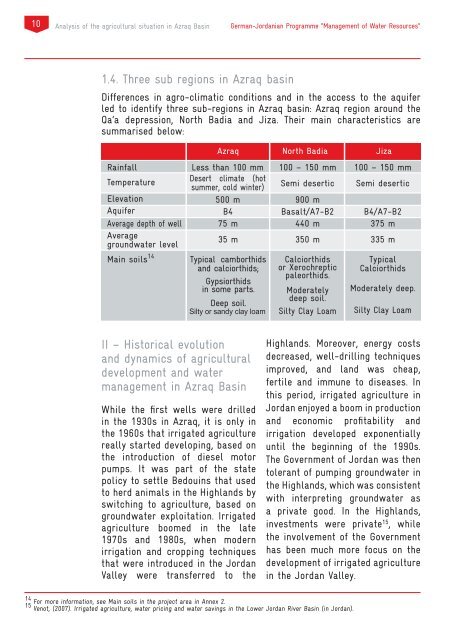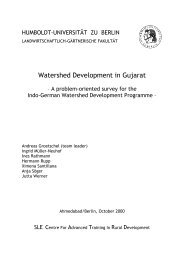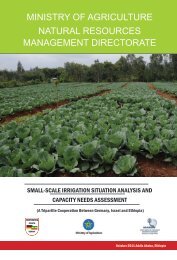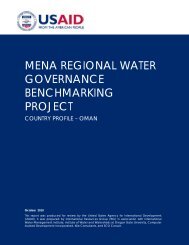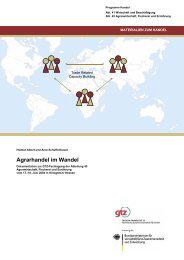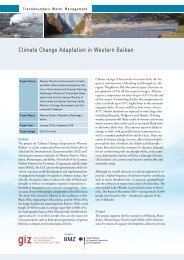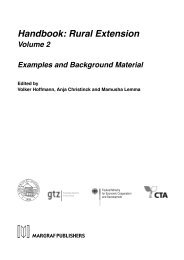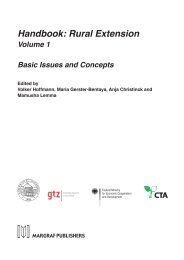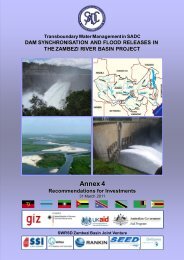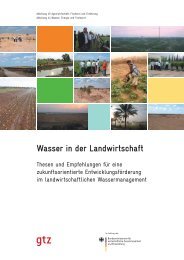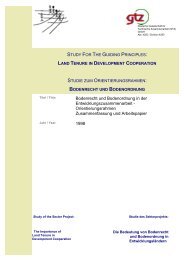Farming in the - WordPress.com
Farming in the - WordPress.com
Farming in the - WordPress.com
You also want an ePaper? Increase the reach of your titles
YUMPU automatically turns print PDFs into web optimized ePapers that Google loves.
10<br />
Virojet<br />
Dripper (GR)<br />
Analysis of <strong>the</strong> agricultural situation <strong>in</strong> Azraq Bas<strong>in</strong><br />
60%<br />
70%<br />
85%<br />
90%<br />
German-Jordanian Programme “Management of Water Resources”<br />
Ra<strong>in</strong>fall<br />
Basalt<br />
400 MCM/y (100%)<br />
B4<br />
250 MCM/y (100%)<br />
1.4. Three sub regions <strong>in</strong> Azraq bas<strong>in</strong><br />
Run-off<br />
5.3%<br />
4.4%<br />
Differences Evapotranspiration <strong>in</strong> agro-climatic conditions 82.6% and <strong>in</strong> <strong>the</strong> access to 92.4% <strong>the</strong> aquifer<br />
led Recharge to identify from three <strong>in</strong>filtration sub-regions <strong>in</strong> Azraq 12.1% bas<strong>in</strong>: Azraq region 3% around <strong>the</strong><br />
Qa’a depression, North Badia and Jiza. Their ma<strong>in</strong> characteristics are<br />
summarised below:<br />
Ra<strong>in</strong>fall<br />
Temperature<br />
Elevation<br />
Aquifer<br />
Average depth of well<br />
Average<br />
groundwater level<br />
Ma<strong>in</strong> soils 14<br />
Azraq<br />
Less than 100 mm<br />
Desert climate (hot<br />
summer, cold w<strong>in</strong>ter)<br />
500 m<br />
B4<br />
75 m<br />
35 m<br />
Typical camborthids<br />
and calciorthids;<br />
Gypsiorthids<br />
<strong>in</strong> some parts.<br />
Deep soil.<br />
Silty or sandy clay loam<br />
North Badia<br />
100 – 150 mm<br />
Semi desertic<br />
900 m<br />
Basalt/A7-B2<br />
440 m<br />
350 m<br />
Calciorthids<br />
or Xerochreptic<br />
paleorthids.<br />
Moderately<br />
deep soil.<br />
Silty Clay Loam<br />
Jiza<br />
100 – 150 mm<br />
Semi desertic<br />
B4/A7-B2<br />
375 m<br />
335 m<br />
Typical<br />
Calciorthids<br />
Moderately deep.<br />
Silty Clay Loam<br />
II – Historical evolution<br />
and dynamics of agricultural<br />
development and water<br />
management <strong>in</strong> Azraq Bas<strong>in</strong><br />
While <strong>the</strong> first wells were drilled<br />
<strong>in</strong> <strong>the</strong> 1930s <strong>in</strong> Azraq, it is only <strong>in</strong><br />
<strong>the</strong> 1960s that irrigated agriculture<br />
really started develop<strong>in</strong>g, based on<br />
<strong>the</strong> <strong>in</strong>troduction of diesel motor<br />
pumps. It was part of <strong>the</strong> state<br />
policy to settle Bedou<strong>in</strong>s that used<br />
to herd animals <strong>in</strong> <strong>the</strong> Highlands by<br />
switch<strong>in</strong>g to agriculture, based on<br />
groundwater exploitation. Irrigated<br />
agriculture boomed <strong>in</strong> <strong>the</strong> late<br />
1970s and 1980s, when modern<br />
irrigation and cropp<strong>in</strong>g techniques<br />
that were <strong>in</strong>troduced <strong>in</strong> <strong>the</strong> Jordan<br />
Valley were transferred to <strong>the</strong><br />
Highlands. Moreover, energy costs<br />
decreased, well-drill<strong>in</strong>g techniques<br />
improved, and land was cheap,<br />
fertile and immune to diseases. In<br />
this period, irrigated agriculture <strong>in</strong><br />
Jordan enjoyed a boom <strong>in</strong> production<br />
and economic profitability and<br />
irrigation developed exponentially<br />
until <strong>the</strong> beg<strong>in</strong>n<strong>in</strong>g of <strong>the</strong> 1990s.<br />
The Government of Jordan was <strong>the</strong>n<br />
tolerant of pump<strong>in</strong>g groundwater <strong>in</strong><br />
<strong>the</strong> Highlands, which was consistent<br />
with <strong>in</strong>terpret<strong>in</strong>g groundwater as<br />
a private good. In <strong>the</strong> Highlands,<br />
<strong>in</strong>vestments were private 15 , while<br />
<strong>the</strong> <strong>in</strong>volvement of <strong>the</strong> Government<br />
has been much more focus on <strong>the</strong><br />
development of irrigated agriculture<br />
<strong>in</strong> <strong>the</strong> Jordan Valley.<br />
14 For more <strong>in</strong>formation, see Ma<strong>in</strong> soils <strong>in</strong> <strong>the</strong> project area <strong>in</strong> Annex 2.<br />
15 Venot, (2007). Irrigated agriculture, water pric<strong>in</strong>g and water sav<strong>in</strong>gs <strong>in</strong> <strong>the</strong> Lower Jordan River Bas<strong>in</strong> (<strong>in</strong> Jordan).


